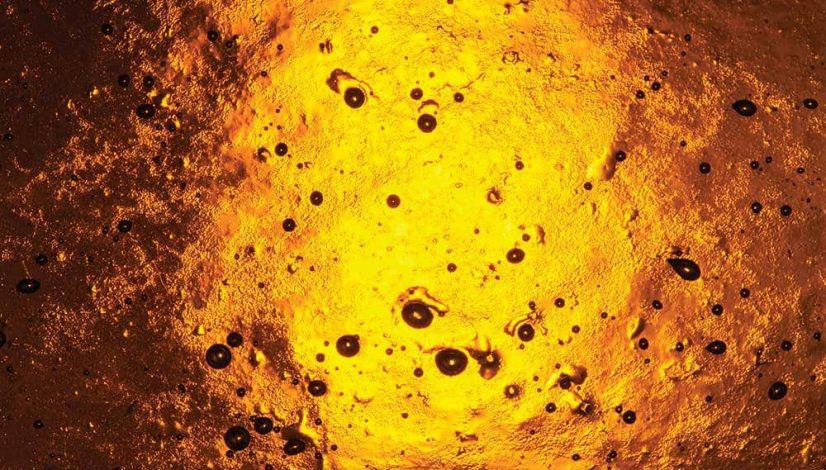What The Future Holds For Concentrates
The post What The Future Holds For Concentrates appeared first on High Times.
Never before has there been such astonishing progress in the science of cannabis and our understanding of how it works in conjunction with our bodies and minds. The recent innovations in the hugely popular world of concentrates illuminate how effective and important a role they’ll play in the cannabis community.
Previously, we looked at the history of concentrates, the different types and how they’re made.
Now let’s take a look at how cannabis concentrates work, explore new and improved techniques to extract and consume them, and examine the overall promise that concentrates may hold for the future.
The Synergy Of Terps And THC
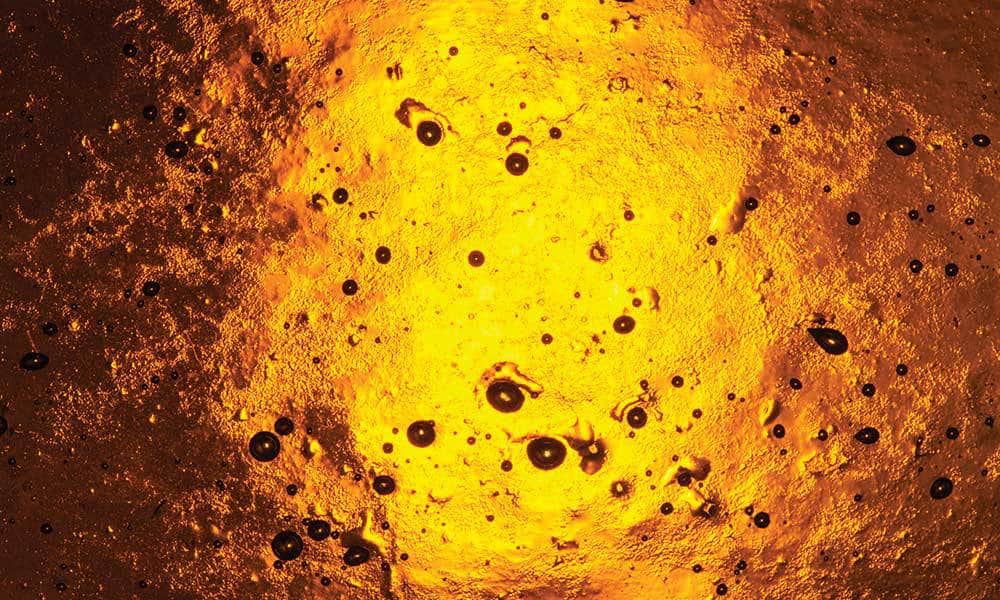
Cannabis oil that has been extracted from the plant material awaits its purge to remove solvents. (Photo by Justin Cannabis/High Times)
As any reader of High Times likely already knows, cannabis is made up of cannabinoids like THC, CBD, CBN and the essential oils known as terpenes.
One of those cannabinoids, an acidic carboxyl group known as THC-A, has many health benefits, including neuroprotective and anti-inflammatory properties, as well as helping to regulate the body’s endocannabinoid system. But the magic really begins when THC-A is heated to 220°F. The carboxyl group is removed from THC-A through a process known as decarboxylation, leaving behind THC, the psychoactive component of cannabis that provides the euphoric feeling of being high. Yet THC by itself has no real direction: There is no specific guidance to the way it makes you feel—much like the erratic sounds of a piano with a cat strolling across the keys.
Terpenes play an integral role in managing the specific effects of cannabis. These are the essential oils that lend their distinctive tastes and aromas to the plant. When terpenes are applied to THC, the effect is greater than the sum of its parts (commonly known as the “entourage effect”), and the result is a mystical synergy that complements the human body and mind. Think of it as something like the way a car works: THC is the catalyst, the gasoline that powers the engine, but without something steering, the car drives around aimlessly. Terpenes are the steering wheel that guides the car in its journey and directs its particular path.
Myrcene, a terpene with an earthy smell much like a mixture of gasoline and cloves, provides a sedating, muscle-relaxing and appetite-stimulating effect when smoked with THC. Ever sink back into the couch after a toke and suddenly realize that three hours have gone by? You most likely have myrcene to thank for that. Conversely, the terpene known as limonene produces a pronounced citrusy scent. What happens when you smell a fresh lemon or orange early in the morning? It wakes you up and gets the blood going. Combined with the entourage effect of THC and other cannabinoids like CBD, CBN and CBG, limonene invigorates you: The mind opens up and soars, creativity flows, and the body becomes energized with increased motivation. Not only is this an enormously pleasant feeling, but it’s also very useful as a tool for mental enhancement. Figuring out how the terpene profiles of specific strains affect the individual can allow the cannabis consumer to select particular strains for their desired results, much like people use different pharmaceuticals—although cannabis doesn’t come with all of the negative side effects of pills. Want to stimulate the mind, stir the creative juices, and get yourself motivated? Dab some Haze or Jack Herer—sativas that contain limonene along with other uplifting terpenes like terpineol and linalool. It truly is a sort of scientific aromatherapy!
More On Terpenes
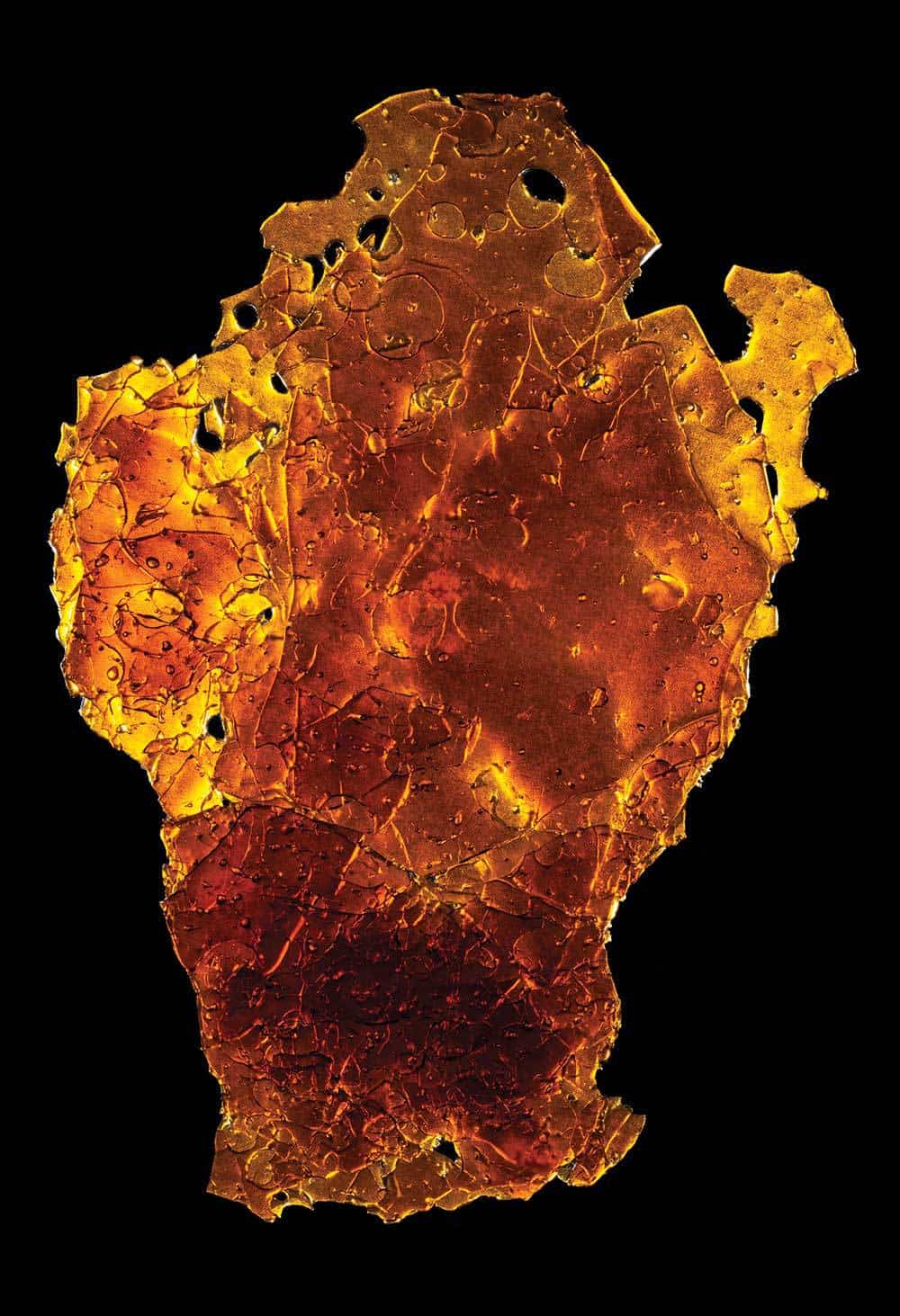
A hefty slab of stable concentrate that can be further processed to isolate its THC-A content. (Photo by Justin Cannabis/High Times)
The term “terpenoid” is often used to describe a compound while it’s still present in a living flower. The difference between terpenes and terpenoids is that terpenes are hydrocarbons, whereas terpenoids contain additional functional groups. These groups are other atoms or bonds within molecules that are often lost during drying or curing, thus resulting in a compound known as a terpene. There are nearly 200 terpenoids that have been identified in cannabis, and most are found in other plants as well.
For example, limonene, which lends a citrus-like aroma to cannabis, is indeed the same terpene found in lemons. When isolated and put side by side, the limonene in cannabis and lemons have identical molecular structures. Moreover, monoterpenes like pinene will vaporize more rapidly at lower temps, while sesquiterpenes like caryophyllene and humulene vaporize only at higher ones. Preserving them all is one of the keys to providing full-spectrum, unadulterated flavor—precisely what the cannabis plant’s essential oils “map out.” It is also important to understand that the effects that each terpene produces are changed when combined with other cannabinoids or terps. THC combined with limonene might provide an uplifting effect, but may produce a completely different result when combined with myrcene.
A Look At Some Of The Major Terpenes, As Well As Their Effects And Boiling Point In Vaporizers
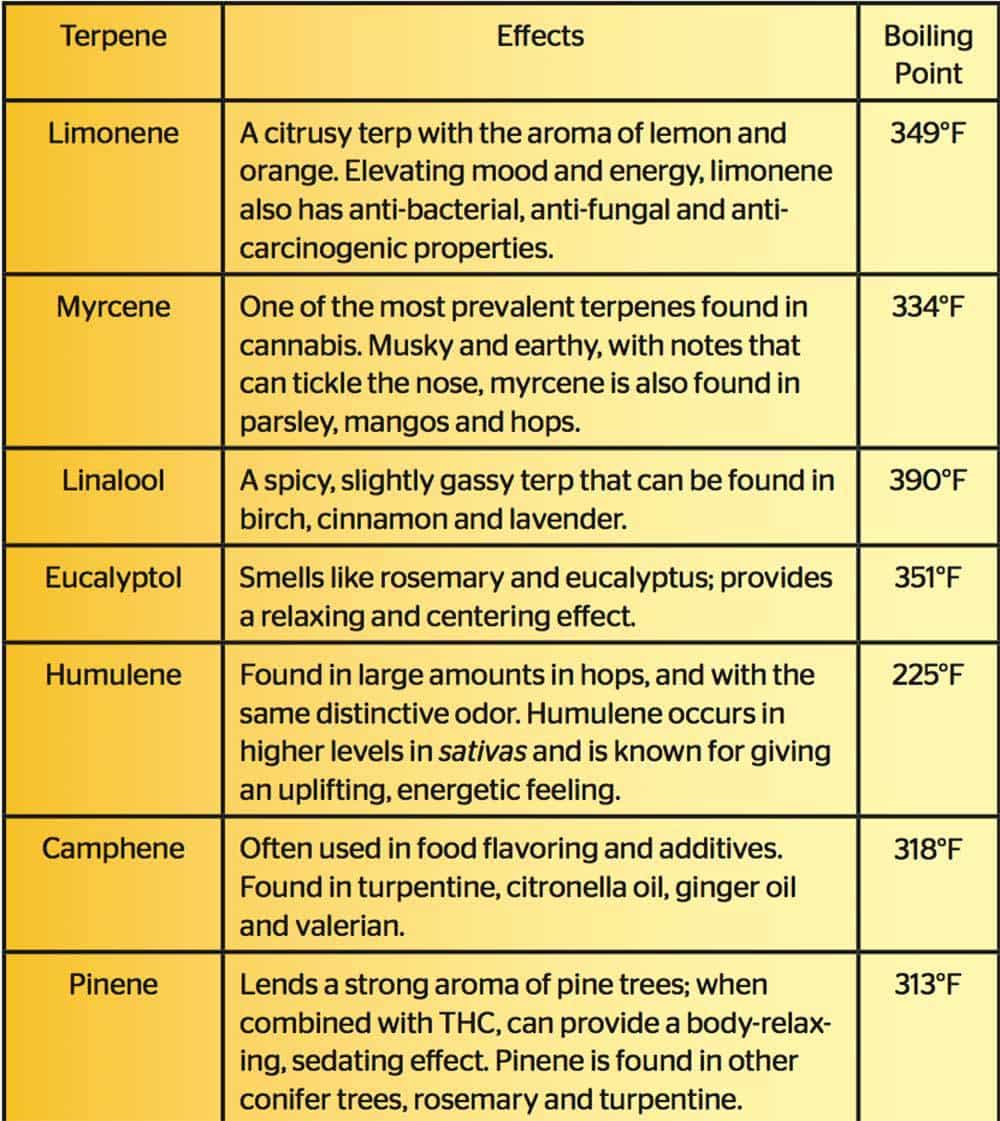
The Science Of Dabbing

Heating your nail red hot helps remove any burnt residue. Don’t forget to let it cool down!
Understanding the fundamentals of how THC-A is converted into THC, as well as how terpenes volatilize, will provide a crucial insight into how to consume concentrates in a more refined way, especially when dabbing. For the uninitiated, dabbing is the process of applying a small amount of concentrate (or “dab”) to a hot surface (“nail”) that’s affixed to a specialized bong (“rig”); the concentrate is then vaporized and inhaled without the nasty fumes of a lighter, the harsher smoke of plant material, or other unnecessary components of cannabis that don’t add to the high.
Knowing that THC turns from oil into vapor at 314.6°F, and that the most stable terpenes and cannabinoids vaporize at a maximum temperature of 428°F, tells us that temperatures much higher than that can scorch or even burn these components of the dab, leaving a burnt black tar on the nail. This essentially incinerates the dab’s terpenes as well as the “mapping” effect they create for the flavor and high.
In fact, when you light a joint, it’s the plant material just before the ember that gets you high, not the material burning in the ember. The heat emanating from the ember is enough to provide temperatures sufficient to convert the THC-A into THC and volatilize everything in the adjacent plant material. As mentioned, THC reaches its boiling point at 314.6°F, and all of the other cannabinoids and terpenes at no higher than 428°F, while the ember of a joint can reach 1,300F°! Thus, the greater portion of the cannabinoids and terpenes in the ember have already been incinerated.
Clean Dab Etiquette

Lower quality dry wax is ideal for further isolation techniques.
Gone are the days when nails were dabbed while still glowing red-hot from a torch. Growers and extractors are so meticulous in creating the best terpene-filled concentrates that it would be a shame to degrade the high-quality flavors in the process of enjoying them. There are a few new tools that have been added to the dabber’s arsenal in order to elevate the experience of smoking concentrates: These include a timer, cotton swabs, rubbing alcohol, a “carb cap” and some patience.
While quartz nails and “bangers”—i.e., an elongated, curved stem with a bucket nail—aren’t particularly new, they provide the easiest kind of surface to keep clean, since the walls are smooth, leaving little purchase for the residue to cling to. Even so, any buildup of residue will quickly grow, as it provides a place for the next dab to seep into and smolder, lending a slightly burnt flavor to the experience. Remember, the goal is to enjoy a fresh dab without incinerating the terpenes and cannabinoids, which provides a cleaner, more specific high reflecting the natural properties of the strain being smoked.

Quartz nails and domeless bangers provide a cleaner and purer dab.
Wiping down the surface of the nail with a cotton swab soaked in alcohol will clean up most of the residue from a previous dab. Using the torch and getting the nail red-hot, you can focus your cleaning efforts on any dark spots until they burn away; this will ensure a clean surface and extend the life of the nail exponentially.
The key here is to wait for the nail to cool off to an appropriate temperature. Remember, THC vapes at 314.6°F, and the most volatile cannabinoid maxes out at 428°F. This is where you should cue the timer: Depending on the thickness of the nail, use the timer to figure out long it takes the nail to cool from red-hot to an appropriate temperature (laser thermometers work well here). The nail should be hot enough to bubble and boil the dab when applied, but not so hot as to throw off lots of smoke—just a tiny bit. It’s not until you cover the nail with the carb cap (which restricts the airflow and creates convection) that the oil should start to smoke heavily.
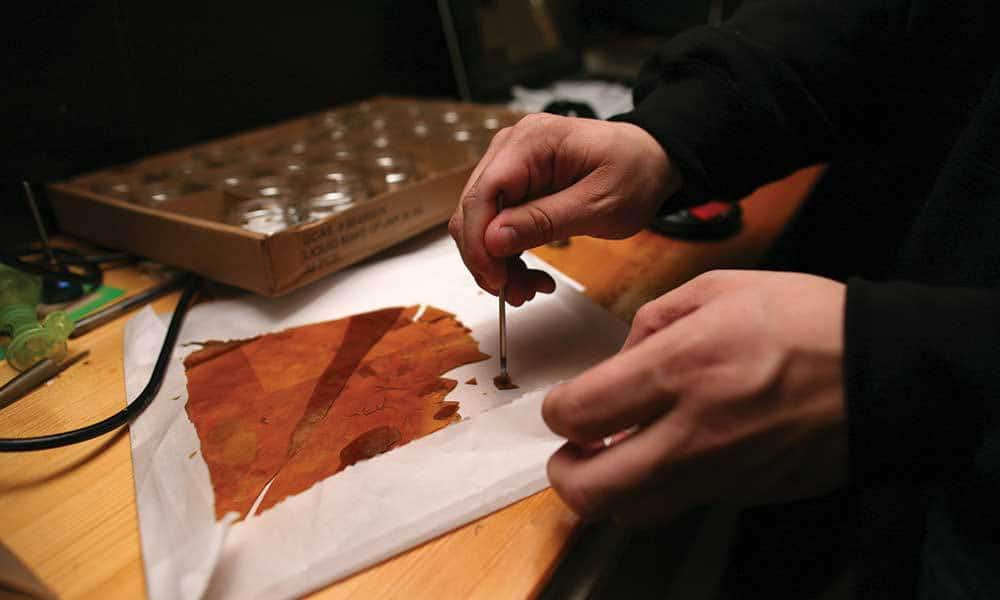
Nothing beats a single solvent run of high quality herb.
Depending on how thick of a smoke you want, you can adjust the time. The leftover residue on the nail should be just a shade or two darker than the dab in its raw form in the jar. If it’s turned black or gotten too dark, the terpenes and some cannabinoids have been scorched or burned away, changing your toking experience. One of the most important things here is finding that sweet temperature spot for the nail, since thinner nails cool off faster, while thicker ones retain their heat more steadily—but also need more time to warm up and cool off. Also, cleaning the nail while it’s still warm is infinitely easier than cleaning one that’s cooled off.
Advances For Concentrates

Near-white THC-A crystals that have been isolated from most other cannabinoids and terpenes. (Photo by Ry Prichard/High Times)
Talking about the progress in concentrates could involve a new conversation every day, since that progress advances at such a rapid pace. More and better science has cultivated a scene that has revealed ways to further isolate what cannabis has to offer and use it in new and beneficial ways. Now that we’ve improved our understanding of how to consume concentrates, let’s discuss some of the newer extraction techniques and products.
Distillates account for a significant portion of the concentrates being consumed at present. Runny like maple syrup, distillates can be found in oral syringes in order to dispense easily. Most often, you’ll find them in pre-filled vape-pen cartridges, as the fluidity allows for a better contact to the heat source. But what exactly is a distillate? They’re often made using hydrocarbon solvents (butane, propane, pentane, hexane, etc.) in a wiped-film short-path distillation process—a method that uses a Roto-Vape, a concentrate-filled flask sitting in a bath that spins while the water is slowly heated.
As the heat rises, each component of the concentrate turns from a liquid into a gas. The gases travel up tubes and recondense at their components’ specific temperatures, collecting in different chambers. This allows the cannabinoids to be separated from the terpenes and other elements, leaving a sometimes golden-colored liquid. Even more advanced, some processors are able to perform this whole process under vacuum. This allows the heating of the material to occur at much lower temperatures, as the boiling points of the various components are reduced under lowered atmospheric pressure. This decreases the degradation of the material and keeps the end result as clear as possible. It is very important to note that this does not remove all remnants of pesticides or industrial chemicals—which is why there’s no substitute for growing organic, pesticide-free cannabis.
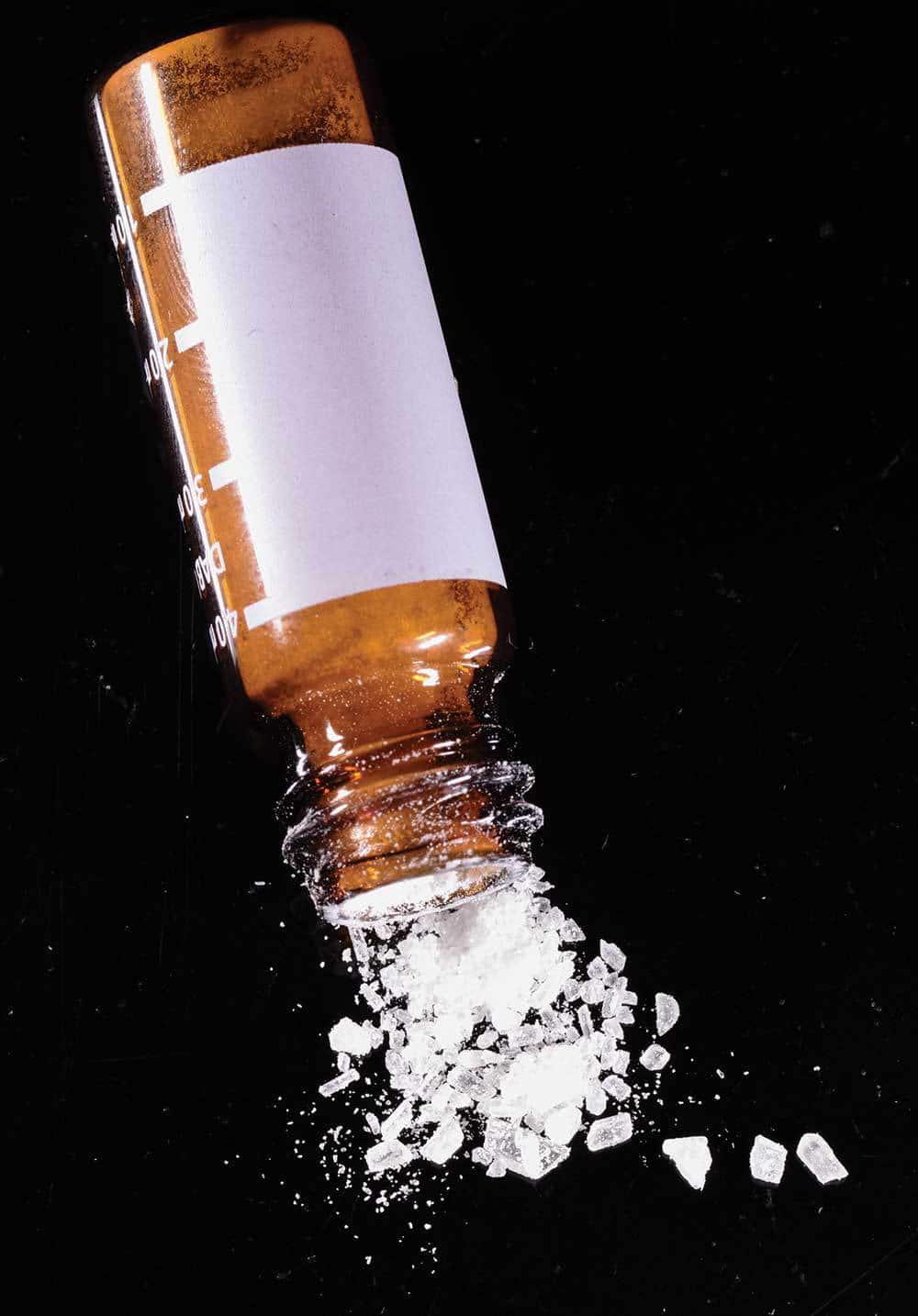
A jar of pure CBD isolate crystals. (Photo by Ry Prichard/High Times)
CBD isolate is a pure form of CBD that can be extracted from high-CBD cannabis and hemp. Somewhat similar to the short-path distillation process, the procedure should be repeated several times to ensure a purer product before immersing the distillate into pentane or hexane. Heat is applied and then the distillate cooled several times. Some extractors drop in a few “seeds” (i.e., a few small CBD crystals) to help instigate growth and quicken the process. If left in a dark and undisturbed location, the crystals will start to bloom. When the crystal growth slows down, the remaining pentane is vacuum-purged and the beautifully formed crystals removed. If desired, one can further refine the crystals by a light washing to remove any impurities from their surface.
THC-A crystalline can look like a quartz crystal and is derived in an almost identical process as CBD isolates. The major differences start with the material that is being extracted. Strains high in THC-A but low in CBD will precipitate THC-A crystals, while low-THC/high-CBD strains and hemp (i.e., with less than 0.003% THC) will result in CBD crystal blooms. CBD has a lower boiling point, which can make it easier to isolate; THC-A can be a bit more finicky and requires more attention. Matt Van Benschoten of Beezle Extracts says that his company goes so far as to “place our resting material on thick mats, to keep any shaking or vibrations from disturbing the blooming process, as they can terminate crystallization.”
Tony Veruza, CEO of Blue River Extracts and the winner of several Cannabis Cups, says that his company has found that it can even “grow” crystals in a good amount of terpenes instead of using a second solvent (since terpenes are a solvent themselves). This eliminates the need to introduce solvents like hexane or pentane and then worry about purging them completely, since it can be difficult to fully purge some solvents from THC-A in crystal form and will sometimes require several washes to maintain purity.
High-terpene, full-spectrum extractions, or HTFSE, have become highly popular of late and generally provide a very potent smell when opened due to the high ratio of terpenes present. Usually, the plant material used for these extractions will be fresh, undried and uncured—i.e., material that’s been kept cool in order to preserve the maximum amount of terpenes. A live resin base is extracted using a solvent such as butane, pentane or the like. This extract then gets put in a large jar and set to rest and cure for a week or two. “THC-A wants to be in crystal form, and given enough time and the proper environment, it will eventually crash out and separate, with crystals on the bottom and the terpenes up top,” Van Benschoten of Beezle Extracts says. “This makes an apple-sauce-like end product that is high in terpenes, with ridiculous flavor.”
While extracting from fresh, undried material is popular these days, the folks at Blue River prefer a slightly different method. Using fresh material can sometimes result in a slight back note to the flavor of a dab that Veruza describes as “wet and tinny …. We prefer to cure our flowers for five to six days, but in a cool environment below 60°F to preserve those volatile terpenes. That allows moisture to escape from the plant material while ensuring minimum terpene loss and degradation.”

THC-A crystals with a thin film of mother liquor AKA “terp sauce.” (Photo by Ry Prichard/High Times)
Terpene isolation is another process that has evolved to improve the yield and quality of the recovered terps. Traditionally, terpenes are isolated during the purging process, as the heat used to eliminate the solvent will also remove them. All of the gases removed are collected in a cold trap—a chamber brought to lower temperatures to force the gases to recondense as a liquid. This liquid is then winterized (chilled in a liquid solvent so that the heavier components settle and separate from the lighter ones), resulting in a capture of the precious terpenes.
Yields can vary greatly depending on the starting material and the temperatures reached in the extraction process. Blue River Extracts uses a newer and modified process to increase returns and result in what it believes is a higher-grade product. Using just nitrogen, alcohol and a vacuum oven, its process puts everything under a vacuum to lower the boiling point of all of the components. Next, Blue River introduces steam to pull out the terpenes, which are then cold-trapped and recovered separately. Cannabis terpenes can be very expensive to extract due to their low yields: Isolating 8 milliliters of terpenes from a pound of cannabis flowers is an average yield with good material.
The Future Of Dabs And The Industry

This Juicy Fruit live resin is high in terpenes and resembles apple sauce with its thick and chunky consistency. (Photo by Ry Prichard/High Times)
What do these isolation methods mean? First off, isolating THC-A is a precursor of bigger things to come. In general, the cannabis community isn’t running to dispensaries to purchase isolated THC-A, which counts as more of a novelty item at present. But this is common when such a new and different product emerges, since it can take time to understand and realize the possibilities. To date, a handful of people have created a sort of “terp kit” containing a jar of THC-A and several jars of full-strain-profile terpenes. This lets you create flavors with the same base material and gives you the ability to have dozens of strain flavors at your fingertips—you simply need to add some THC-A crystalline to provide that extra kick.
Distillates are great for making extracts for vape cartridges, but they don’t retain the full flavor of the cannabis due to the process involved in creating them, and therefore terpenes need to be reintroduced. Quite often, food-grade terps are added to vape-pen cartridges, much like the juice in e-cigarette pens—but the health effects are still unknown, and most cannabis purists are against this kind of adulteration.
A great deal of concentrates’ future potential lies in the commercialization and industrialization of cannabis as a whole. Cannabis that may not be fit for consumption (because it was harvested too early, was overly dried or burned, or contains seeded buds or old or bad-quality flowers and trim, etc.) can now be broken down into its basic parts and utilized in reconstructing acceptable products. The THC-A extracted from Mexican “brick weed,” once isolated, is the same as the THC-A extracted from the best cannabis in the world. This allows cultivators to focus less on growing quality meds—a process that can be costly—and focus on quantity and THC-A production instead. Large fields of lower-grade cannabis can now find a market as well. Whether for better or worse, this model is exactly what industrialization and commercialization do to ensure the best returns on investment.
The market has proven that it will sustain mass-produced, inexpensive commercial extracts as well as hand-crafted, organically grown and responsibly cultivated small-batch boutique concentrates. This is why it’s enormously important that we understand these aspects of the extraction process and take an active part in deciding what we deem acceptable for the future of cannabis concentrates.
The post What The Future Holds For Concentrates appeared first on High Times.

